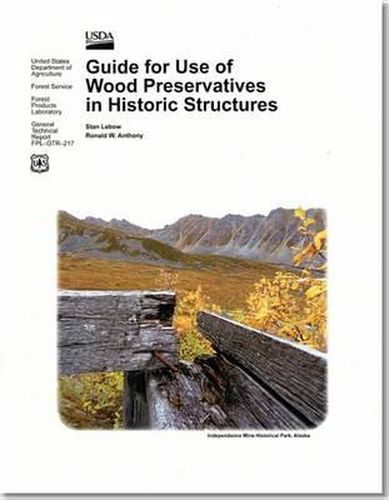Readings Newsletter
Become a Readings Member to make your shopping experience even easier.
Sign in or sign up for free!
You’re not far away from qualifying for FREE standard shipping within Australia
You’ve qualified for FREE standard shipping within Australia
The cart is loading…






NOTE: NO FURTHER DISCOUNT FOR THIS PRINT PRODUCT– OVERSTOCK SALE – Significantly reduced list price Wood preservatives are generally grouped into two categories: preservatives used for in-place field (remedial)treatment and preservatives used for pressure treatments.A limitation of in-place treatments is that they cannot beforced deeply into the wood under pressure. However, theycan be applied into the center of large wooden membersvia treatment holes. These preservatives may be availableas liquids, rods, or pastes. Pressure-treated wood has muchdeeper and more uniform preservative penetration thanwood treated with other methods. The type of pressuretreated wood is often dependent on the requirements of thespecific application. To guide selection of pressure-treatedwood, the American Wood Protection Association developedUse Category System standards. Other preservative characteristics, such as color, odor, and surface oiliness may alsobe relevant. Guidelines for selection and application of fieldtreatments and for selection and specification of pressure-treated wood are provided in this document. Related Products:
Nondestructive Evaluation of Wood is available here: https: //bookstore.gpo.gov/products/sku/001-001-00704-8
New Exterior Additions to Historic Buildings: Preservation Concerns is available here: https: //bookstore.gpo.gov/products/sku/024-005-01280-0
Guide for In-Place Treatment of Wood in Historic Covered and Modern Bridges is available here: https: //bookstore.gpo.gov/products/sku/001-001-00695-5
Preserving Historic Wood Porches is available here: https: //bookstore.gpo.gov/products/sku/024-005-01240-1
Preservation Briefs: Recognizing and Resolving Common Preservation Problems, 1-14 is available here: https: //bookstore.gpo.gov/products/sku/024-005-01026-2
Preservation Briefs: 15-23 (2007) is avaiable here: https: //bookstore.gpo.gov/products/sku/024-005-01256-7
Preservation Briefs 24-34: Recognizing and Resolving Common Preservation and Repair Problems Prior to Working on Historic Buildings is available here: https: //bookstore.gpo.gov/products/sku/024-005-01147-1
Preservation Briefs 35-42: Recognizing and Resolving Common Preservation and Repair Problems Prior to Working on Historic Buildings is available here: https: //bookstore.gpo.gov/products/sku/024-005-01219-2
Renovation & Historic Preservation resources collection can be found here: https: //bookstore.gpo.gov/catalog/science-technology/construction-archit
$9.00 standard shipping within Australia
FREE standard shipping within Australia for orders over $100.00
Express & International shipping calculated at checkout
NOTE: NO FURTHER DISCOUNT FOR THIS PRINT PRODUCT– OVERSTOCK SALE – Significantly reduced list price Wood preservatives are generally grouped into two categories: preservatives used for in-place field (remedial)treatment and preservatives used for pressure treatments.A limitation of in-place treatments is that they cannot beforced deeply into the wood under pressure. However, theycan be applied into the center of large wooden membersvia treatment holes. These preservatives may be availableas liquids, rods, or pastes. Pressure-treated wood has muchdeeper and more uniform preservative penetration thanwood treated with other methods. The type of pressuretreated wood is often dependent on the requirements of thespecific application. To guide selection of pressure-treatedwood, the American Wood Protection Association developedUse Category System standards. Other preservative characteristics, such as color, odor, and surface oiliness may alsobe relevant. Guidelines for selection and application of fieldtreatments and for selection and specification of pressure-treated wood are provided in this document. Related Products:
Nondestructive Evaluation of Wood is available here: https: //bookstore.gpo.gov/products/sku/001-001-00704-8
New Exterior Additions to Historic Buildings: Preservation Concerns is available here: https: //bookstore.gpo.gov/products/sku/024-005-01280-0
Guide for In-Place Treatment of Wood in Historic Covered and Modern Bridges is available here: https: //bookstore.gpo.gov/products/sku/001-001-00695-5
Preserving Historic Wood Porches is available here: https: //bookstore.gpo.gov/products/sku/024-005-01240-1
Preservation Briefs: Recognizing and Resolving Common Preservation Problems, 1-14 is available here: https: //bookstore.gpo.gov/products/sku/024-005-01026-2
Preservation Briefs: 15-23 (2007) is avaiable here: https: //bookstore.gpo.gov/products/sku/024-005-01256-7
Preservation Briefs 24-34: Recognizing and Resolving Common Preservation and Repair Problems Prior to Working on Historic Buildings is available here: https: //bookstore.gpo.gov/products/sku/024-005-01147-1
Preservation Briefs 35-42: Recognizing and Resolving Common Preservation and Repair Problems Prior to Working on Historic Buildings is available here: https: //bookstore.gpo.gov/products/sku/024-005-01219-2
Renovation & Historic Preservation resources collection can be found here: https: //bookstore.gpo.gov/catalog/science-technology/construction-archit